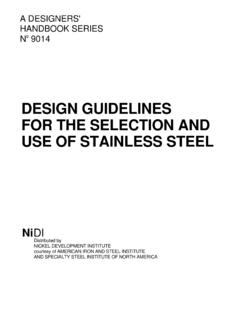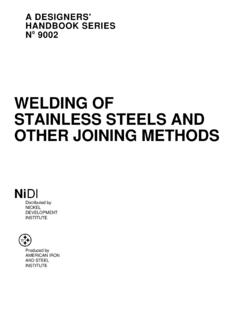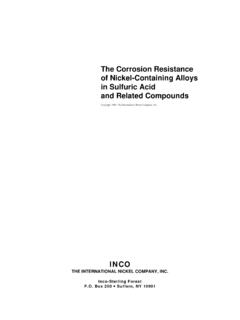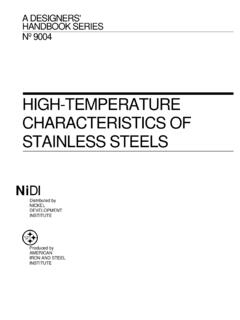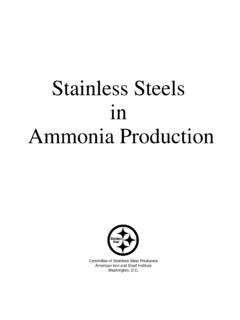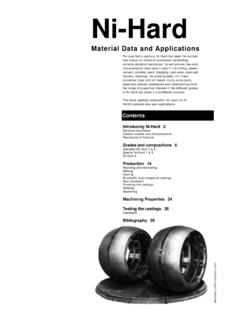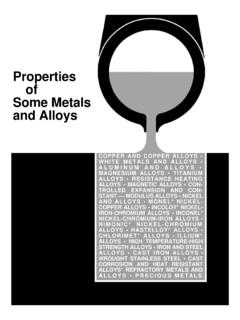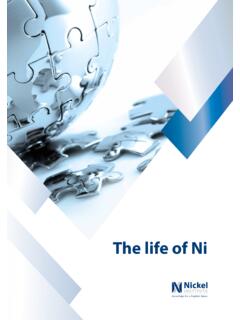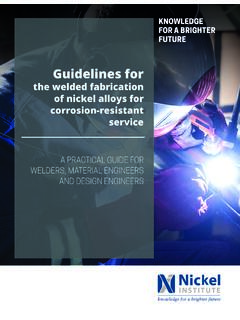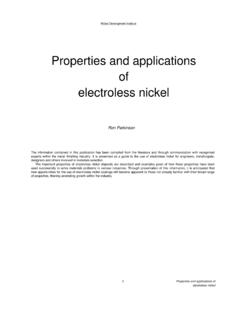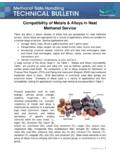Transcription of High- Performance Stainless Steels - Nickel Institute
1 High- PerformanceStainless SteelsThe material presented in this reference book has been prepared for the general information of the reader and shouldnot be used or relied upon for specific applications withoutfirst securing competent Development Institute , its members, staff, and consultants do not represent or warrant its suitability for any general or specific use and assume no liability or responsibility of any kind in connection with the information herein. Drawings and/or photographs ofequipment, machinery, and products are for illustrativepurposes only, and their inclusion does not constitute or imply any endorsement of the companies that manufacture or distribute report was prepared by Curtis W.
2 Kovach, Technical Marketing Resources, Inc., Pittsburgh, PA,USA, consultant to the Nickel Development Front Cover shows a heat exchanger withSAF 2507 tubes for aggressive chloride serviceIntroduction.. 3 Classification of Grades.. 4 Austenitic High- Performance Stainless Steels .. 4 Ferritic High- Performance Stainless Steels .. 7 Duplex High- Performance Stainless Steels .. 8 Physical Metallurgy.. 9 Phase Relations in the Iron-Chromium- Nickel System.. 9 Secondary Phases.. 13 Kinetics of Phase Precipitation Reactions..15 Austenitic Stainless Steels .
3 16 Ferritic Stainless Steels .. 17 Duplex Stainless Steels .. 18 Mechanical Properties.. 20 Austenitic Stainless Steels .. 20 Ferritic Stainless Steels .. 25 Duplex Stainless Steels .. 27 Physical Properties.. 29 corrosion resistance .. 35 resistance to Inorganic Acids.. 35 resistance to Organic Acids.. 40 resistance to Alkalies and Alkaline Salts.. 42 Chloride- and Other Halide Ion-Containing Aqueous Environments.. 44 Near Neutral Environments Natural Waters and Brines.. 48 Influence of Microbial Activity.. 53 Oxidizing Halide Environments Chlorinated Cooling Waters and Bleach Solutions.
4 53 Acidic Environments Containing Halides Flue Gas Condensates.. 56 Stress corrosion Cracking.. 60 Water and Brine Environments.. 62 Sour Oil and Gas Environments.. 64 Hydrogen Environments.. 66 corrosion Acceptance Tests.. 67 TABLE OF CONTENTSF abrication.. 70 Hot Working.. 70 Cold Working.. 71 Annealing.. 72 Machining.. 74 Welding.. 75 Austenitic Stainless steel Grades.. 75 Ferritic Stainless steel Grades.. 79 Duplex Stainless steel Grades.. 79 Surface Condition.. 82 Applications.. 83 Acknowledgements.. 85 Works Cited.. 85 Appendix 1.
5 89 Appendix 2 (A).. 91 Appendix 2 (B).. 91 Appendix 2 (C).. 92 Appendix 3.. 92 Appendix 4.. 93 TABLE OF CONTENTS (continued) High- Performance Stainless Steels 3as individual grades, may offer optimumperformance for a specific requirement. Thehigher Nickel austenitic grades are generallypreferred for severe acid service and forresistance to chloride pitting and stress corrosioncracking. They are often selected for flue gascleaning equipment handling acid condensates,or acidic solutions containing strong oxidantssuch as in paper bleaching.
6 Where fieldfabrication is an important consideration, theaustenitic grades are favoured because of theirrelative ease of welding; grades from this familyhave been used extensively in offshore andnuclear piping where weld quality is extremelyimportant. If the requirement is for thin sheet, theferritic grades will usually be most cost-effective;therefore, they have been used as the tubematerial in many kinds of heat exchangers. Theduplex grades are often selected where strengthis advantageous. They have been used inpressure vessels for the chemical processindustry, and have seen extensive service in heatexchangers.
7 All three families of the High- Performance Stainless Steels will deliver a widerange of resistance to chloride pitting and stresscorrosion cracking superior to that of Types 304 and 316; so fabricationconsiderations often determine the final materialchoice in the case of chloride High- Performance Stainless Steels are moretechnically demanding than Types 304 and 316with regard to metallurgy and fabricationrequirements. This is due to the nature of the Steels themselves and the demandingapplications in which they are used. A thoroughunderstanding of these Stainless Steels isnecessary to use them successfully.
8 This bookprovides assistance in making the optimummaterial selection for a given application, andprovides guidance in the fabrication and use ofthe selected grade . Because of the complexity ofapplications and large number of gradesavailable, this book can serve only as anintroductory guide. The reader is encouraged toconsult with manufacturers to learn more fully theadvantages, limitations, and specificrequirements of individual High- Performance Stainless Steels are afamily of Stainless Steels which have distinctlysuperior corrosion resistance in a wide variety ofaggressive environments when compared with thestandard Stainless steel grades such as Type*304L, which contains only 18% chromium and8% Nickel (18-8), and Type 316L, which containssimilar chromium and Nickel and 2% molybdenum(18-10-2).
9 Their superiority in resisting pitting andstress corrosion cracking is especially evident inenvironments containing the chloride ion. Thisperformance is obtained by using a high level ofchromium, Nickel , molybdenum, and nitrogenalloying for corrosion resistance , and by producingthese grades with very low carbon contents topreserve this resistance while allowing hotfabrication and welding. The commercial origins ofthe High- Performance Stainless Steels came withthe advent of steel melting and refiningtechnologies that made it possible toeconomically produce compositions having verylow carbon content and close compositioncontrol.
10 Among these technologies are vacuummelting, electron beam remelting, electroslagremelting, and, most notably today from acommercial standpoint, vacuum oxygendecarburization (VOD) and argon-oxygendecarburization (AOD). Beginning in the 1970s,these Stainless Steels have grown in number andin technical and commercial importance. Thisbook provides an introduction to these Steels forthose whose materials needs extend beyond thecapabilities of the standard grades, and for thosewho will benefit from a discussion of theengineering and corrosion Performance propertiesof the High- Performance Stainless are three primary classifications within thehigh- Performance Stainless Steels .
